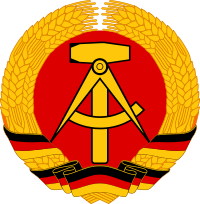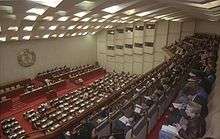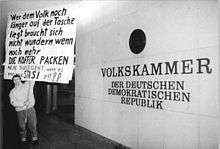Volkskammer
| People's Chamber Volkskammer | |
|---|---|
| Legislature of German Democratic Republic (East Germany) | |
 | |
| Type | |
| Type |
Unicameral parliament (until 1958 lower house) |
| History | |
| Established | 1949 |
| Disbanded | 1990 |
| Preceded by | Reichstag (1933-1945) |
| Succeeded by | Bundestag (1990-today) |
| Seats | 400 |
| Elections | |
Last election | 18 March 1990 |
| Meeting place | |
 | |
| Palast der Republik | |
 |
|---|
| This article is part of a series on the politics and government of East Germany |
The Volkskammer (English: People's Chamber) was the unicameral legislature of the German Democratic Republic (popularly called East Germany).
The Volkskammer was initially the lower house of a bicameral legislature. The upper house was the Chamber of States, or Länderkammer, but in 1952 the states of East Germany were dissolved, and the Chamber was abolished in 1958. Constitutionally, the Volkskammer was the highest organ of state power in the GDR, and both constitutions vested it with great lawmaking powers. All other branches of government, including the judiciary, were theoretically responsible to it. By 1960, the chamber appointed the Council of the State, the Council of Ministers, and the National Defence Council.
In practice, the People's Chamber was a rubber stamp that did little more than give legal sanction to decisions already made by the Socialist Unity Party of Germany (SED) and its Politburo. This was standard operating procedure in nearly all Communist legislatures. All parties were expected to respect the principles of democratic centralism and the leading role of the SED. As a result, all but two measures put before it prior to the Peaceful Revolution passed unanimously.
Membership
From its founding in 1949 until the first competitive elections in March 1990, all members of the Volkskammer were elected via a single list from the National Front, a popular front/electoral alliance dominated by the SED. In addition, seats were also allocated to various organizations affiliated with the SED, such as the Free German Youth.
The members of the chamber were elected in multi-member constituencies, with four to eight seats. To be elected, a candidate needed to receive half of the valid votes cast in their constituency. If, within a constituency, an insufficient number of candidates got the majority needed to fill all the seats, a second round was held within 90 days. If the number of candidates getting this majority exceeds the number of seats in the respective constituency, the order of the candidates on the election list decided who got to sit in the Volkskammer. Candidates who lost out on a seat because of this, would become successor candidates who would fill casual vacancies which might occur during a legislative period.
Only one list of candidates appeared on a ballot paper; voters simply took the ballot paper and dropped it into the ballot box. Those who wanted to vote against the ruling party's list of candidates had to vote using a separate ballot box, without any secrecy.[1] Seats were apportioned based on a set quota, not actual vote totals.[2] By ensuring that its candidates dominated the list, the SED effectively predetermined the composition of the Volkskammer.
The table below shows an overview of the reported results of all parliamentary elections before 1990, with the resulting disposition of parliamentary seats.
| Election date | Participation | Agree | Distribution of parliamentary seats | |||||||||||
|---|---|---|---|---|---|---|---|---|---|---|---|---|---|---|
| SED | CDU | LDPD | DBD | NDPD | FDGB | FDJ | KB | DFD | SDA1 | VdgB | VVN | |||
| 19 October 1950 | 98.53% | 99.9% | 110 | 67 | 66 | 33 | 35 | 49 | 25 | 24 | 20 | 6 | 12 | 19 |
| 17 October 1954 | 98.51% | 99.4% | 117 | 52 | 52 | 52 | 52 | 55 | 29 | 29 | 18 | 12 | ||
| 16 November 1958 | 98.90% | 99.9% | 127 | 52 | 52 | 52 | 52 | 55 | 29 | 29 | 18 | 12 | ||
| 20 October 1963 | 99.25% | 99.9% | 127 | 52 | 52 | 52 | 52 | 68 | 55 | 35 | 22 | |||
| 2 July 1967 | 99.82% | 99.9% | 127 | 52 | 52 | 52 | 52 | 68 | 55 | 35 | 22 | |||
| 14 November 1971 | 98.48% | 99.5% | 127 | 52 | 52 | 52 | 52 | 68 | 55 | 35 | 22 | |||
| 7 October 1976 | 98.58% | 99.8% | 127 | 52 | 52 | 52 | 52 | 68 | 55 | 35 | 22 | |||
| 14 June 1981 | 99.21% | 99.9% | 127 | 52 | 52 | 52 | 52 | 68 | 55 | 35 | 22 | |||
| 8 June 1986 | 99.74% | 99.9% | 127 | 52 | 52 | 52 | 52 | 68 | 37 | 21 | 32 | 14 | ||
1Eastern Bureau of the Social Democratic Party of Germany
In 1976, the Volkskammer moved into a specially-constructed building on Marx-Engels-Platz (now Schloßplatz again), the Palast der Republik (Palace of the Republic). Prior to the opening of the Palast der Republik the Volkskammer meet at Langenbeck-Virchow-Haus in the Mitte district of Berlin.
Initially, voters in East Berlin could not take part in elections to the Volkskammer, in which they were represented by indirectly-elected non-voting members, but in 1979 the electoral law was changed, to provide for 66 directly elected deputies with full voting rights.[3]


After the 1990 election, the disposition of the parties was as follows:
| Party/Group | Acronym | Members |
|---|---|---|
| Alliance for Germany | CDU, DA, DSU | 192 |
| Social Democratic Party of Germany | SPD | 88 |
| Party of Democratic Socialism | PDS, former SED | 66 |
| Association of Free Democrats | DFP, FDP, LDP | 21 |
| Alliance 90 | B90 | 12 |
| East German Green Party and Independent Women's Association | Grüne, UFV | 8 |
| National Democratic Party of Germany | NDPD | 2 |
| Democratic Women's League of Germany | DFD | 1 |
| United Left | VL | 1 |
Presidents of the People's Chamber
The presidency of the People's Chamber was held by a non-Communist for most of that body's existence; only one SED member ever held the title. This was to keep up the appearance that the GDR was governed by a broad-based coalition. The president of the People's Chamber was the third-highest state post in the GDR (after the chairman of the Council of Ministers and the chairman of the State Council) and was ex-officio vice president of the country.
| Name | Entered office | Left office | Party |
|---|---|---|---|
| Johannes Dieckmann | 7 October 1949 | 22 February 1969 | LDPD |
| Gerald Götting | 12 May 1969 | 29 October 1976 | CDU |
| Horst Sindermann | 29 October 1976 | 13 November 1989 | SED |
| Günther Maleuda | 13 November 1989 | 5 April 1990 | DBD |
| Sabine Bergmann-Pohl | 5 April 1990 | 2 October 1990 | CDU |
The last president of the People's Chamber, Sabine Bergmann-Pohl, was also interim head of state during the last six months of East Germany's existence due to the State Council having been abolished.
See also
References
- ↑ Sebetsyen, Victor (2009). Revolution 1989: The Fall of the Soviet Empire. New York City: Pantheon Books. ISBN 0-375-42532-2.
- ↑ Eugene Register-Guard October 29, 1989. p. 5A.
- ↑ Longman Companion to Germany since 1945, Adrian Webb, Routledge, 2014
External links
| Wikimedia Commons has media related to People's Chamber of the German Democratic Republic. |